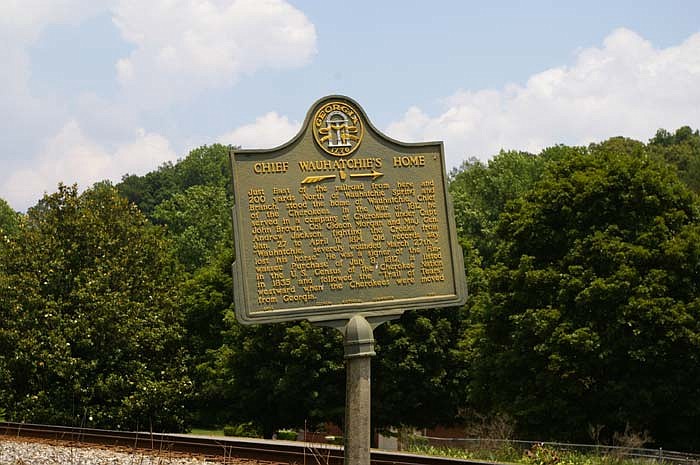On Feb. 28, 2019, the Tennessee Historical Commission and Tennessee Wars Commission announced a $232,000 grant to preserve nine acres of the Wauhatchie Battlefield. The grant would preserve Brown's Tavern, Chattanooga and Hamilton County's oldest original historic structure. John Brown, a Cherokee businessman and leader, had constructed the tavern to take advantage of the settlers moving through the newly opened regions. Subsequently, questions have been asked about Wauhatchie and the Wauhatchie Battlefield's significance.
Residents of Lookout Valley and Tiftonia easily share stories about the community, direct visitors to Wauhatchie Pike and speak with pride about the new Wauhatchie School as a "nature-based school promoting place-based, nature immersion experiences."
Local history enthusiasts remind listeners that Chief Wauhatchie was a 19th-century Cherokee chieftain who fought alongside Maj. Gen. Andrew Jackson, Lt. John Ross, Capt. John Brown and others at the Battle of Horseshoe Bend, War of 1812. The site of his former home in the valley is identified with a historical marker that mentions old records including "Wauhatchie, severely wounded March 27th - lost his horse." He signed the Hiawassee Purchase of July 8, 1817, is listed in the 1835 census of the Cherokee nation and joined the "Trail of Tears" westward removal.
With an understanding of the origin of the name and the location of Wauhatchie, questions still remain about the Battle of Wauhatchie, and yet many will recognize leaders and actions associated with the battle. A quick summary of the battle would include these facts: The Battle of Wauhatchie, Oct. 28-29, 1863, occurred on lands now included in Hamilton and Marion counties, Tennessee, and Dade County, Georgia. Union forces seized Brown's Ferry on the Tennessee River and opened a supply line to the besieged Union army in Chattanooga. Confederate forces countered and attempted to dislodge the federal units, hoping to close the supply line and contribute to the fall of Chattanooga. However, Union forces prevailed at Brown's Ferry [Wauhatchie] and, after intense fighting in late November, Chattanooga remained under U. S. Army control, serving as a "Gateway to the South" and the "Gateway to Freedom."
How did the military action in October 1863 come to focus on Brown's Ferry and Wauhatchie?
Following the Confederate victory at Chickamauga in September 1863, Union forces retreated to Chattanooga to regroup and plan future actions while awaiting reinforcements and supplies. Gen. Braxton Bragg, CSA, took control of Missionary Ridge and Lookout Mountain, both sites providing his army with excellent intelligence about Union troops and their supply lines. As Confederate troops hit Union supply lines, Maj. Gen. U.S. Grant replaced William Rosecrans with Maj. Gen. George H. Thomas, with the order that his first priority was to resupply the Union army.
The initial plan, "Cracker Line Operation," was designed to open the path into Chattanooga from Brown's Ferry with a simultaneous advance up Lookout Valley, taking control of Kelly's Ferry Road. While Confederate leaders took up positions at Brown's Ferry, Moccasin Bend and in the valley, Union forces had landed and were too numerous to be repelled. Meanwhile, Maj. Gen. Joseph Hooker had marched three Union divisions from Bridgeport, following the rail lines, via Shellmound and entered Lookout Valley to the surprise of Gens. Bragg and James Longstreet, who were meeting on Lookout Mountain when the news arrived.
Upon observing the Union advances on Oct. 27 and 28, Longstreet and Bragg decided to mount a night attack at Wauhatchie Station, one of the few night battles of the Civil War. Originally planned for 10 p.m., confusion delayed the attack until midnight. As more and more Union troops arrived, the Confederates were forced back to Lookout Mountain. Federal troops could now receive the munitions, supplies and reinforcements necessary to maintain control of Chattanooga and drive the Confederate troops from Missionary Ridge and Lookout Mountain.
By the numbers, the Battle at Wauhatchie might be considered a skirmish when compared with other battles in the western theater, i.e., Shiloh, Chickamauga, Vicksburg. It is generally accepted that the Confederate forces lost more than 356 men while the Union units, who fielded fewer than 1,600 men, lost between 215 and 220.
Despite the low numbers, the Battle of Wauhatchie changed the military situation around Chattanooga; the Confederates had lost their best chance at gaining control of Chattanooga and perhaps altering the course of the war. As supplies and troops began to flow through Lookout Valley, the federals soon became a strong force in northern Georgia.
Linda Moss Mines, the Chattanooga-Hamilton County historian, is a member of the Tennessee Historical Commission and regent, Chief John Ross Chapter, NSDAR.
